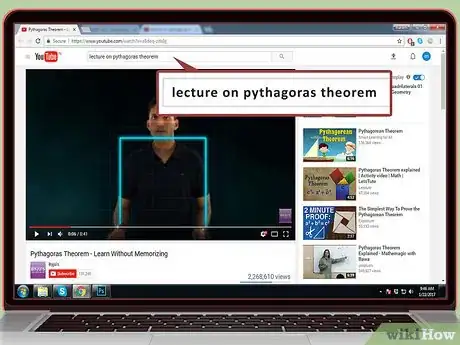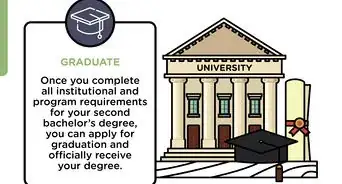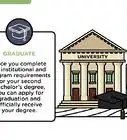This article was co-authored by Christopher Taylor, PhD. Christopher Taylor is an Adjunct Assistant Professor of English at Austin Community College in Texas. He received his PhD in English Literature and Medieval Studies from the University of Texas at Austin in 2014.
There are 7 references cited in this article, which can be found at the bottom of the page.
wikiHow marks an article as reader-approved once it receives enough positive feedback. In this case, 91% of readers who voted found the article helpful, earning it our reader-approved status.
This article has been viewed 76,090 times.
Most people are required to deliver a lecture at some point in their life, whether it be for school, work, or other activities. Delivering a strong lecture will demonstrate intelligence, expertise, and leadership to your audience. However, many struggle to organize their information and may suffer from public speaking anxiety. By learning how to research, develop your content, and deliver the speech, you can impress and educate your audience.
Steps
Researching the Subject
-
1Consider your purpose. The general purpose of your lecture is most likely to inform your audience about something they don’t know. However, you can consider this purpose more deeply. Are you trying to prepare them for an exam on the material? Are you leading them toward developing their own unique thoughts on the subject? Throughout the research and development of your lecture content, ask how you’re serving your overall purpose.
-
2Read diverse sources. Don’t develop your lecture material from a single source. Try to get a diverse perspective from professional texts, academic papers, news sources, and even less formal sources like blog posts. Diverse sourcing will give you a more comprehensive understanding of the subject matter and reflect a more authoritative ethos to your audience.
- It’s good to present scholarly perspectives that conflict with each other. This will demonstrate that you are aware of critical perspectives, present a more comprehensive view of the topic, and give your audience something to think about.
Advertisement -
3Keep track of your sources. Make sure you are properly citing any sources you plan on using in the lecture and know precisely where each piece of information comes from. Keep written bibliography on the side in case someone requests this information.
- Verbal citations for a lecture don’t have to be as complete as written citations for a paper. You can say some like “According to the U.S. Department of Labor’s 2008 study…” before presenting the relevant information. Still, you should have a complete citation that includes the author, date, author’s qualifications, title, publication, relevant page numbers, and instructions for finding the source on the internet or in print in case someone wants to see your sources firsthand.
-
4Listen to similar lectures. Use your preferred internet search engine to find other lectures on similar subjects. This can help you both in developing information for your content and giving you a template for how the lecture can be organized and delivered.[1] YouTube and onlineuniversities.com are good places to find lecture videos.
- As with any other source, make sure you cite the lecture if you are using specific information you gathered from it.
Developing the Content
-
1Start with an outline. Divide your content into major points and use them to set up an outline and develop subpoints underneath the major points. Starting with an outline will help you organize your thoughts and help you get starting in writing the actual wording of the lecture.[2]
- Try to organize for consistency and include a relatively equal amount of information, subpoints, reflective questions, and sources for each larger unit of your outline.
-
2Include an introduction and conclusion. Introductions and conclusions are even more important for verbal lecture than written content because, unlike a written paper, the audience likely won’t be able to go back if they missed something. The introduction should prepare the audience for the most important parts of the lecture and the conclusion should restate those essential parts. [3]
- The statement of purpose should clearly outline the functional value of the lecture. For example, say “By the end of this lecture, you should be able to apply the Pythagorean theorem to calculate the length of sides of a triangle.”
- Directly state the purpose of the lecture in both the introduction and conclusion.
-
3Work in audience participation. Try to work in elements of your speech that are directly engaging the audience. The best way to do this is to include open questions in your lecture and offer an opportunity to for listeners to answer or give their thoughts. Interactive elements will keep your audience involved and give them an opportunity to apply the information or skills they’re learning.
- You can also organize activities for break out sections. You can break your audience into groups and have them and have them debate a subject against other groups or have them review separate case studies. This works specifically for a classroom lecture.
- Ask an open-ended question that requires your audience to reason their answer like “Why do you think that Britain declined to recognize the Confederacy during the American Civil War?”
-
4Tailor the length to the amount of time that you have to speak. Consider ahead of time what you can cover in your allotted time. Generally, it takes 2 minutes to recite 1 double-spaced page, although this can vary from person to person. Assign a certain amount of time to each part of your lecture and time yourself as you practice.[4]
- If you don't have much time, hit only the important points. Try not to go off topic or spend time discussing things that aren't relevant to your main point.
- It is usually better go slightly shorter with your lecture than to go over the time limit.
-
5Anticipate questions and confusion. Try to anticipate parts of your lecture that might be confusing and specific questions that the audience may ask. Where you do anticipate confusion, do your best to clarify each part of the information and make time to respond to questions or concerns. You should also try to demonstrate the concept in a practical way. For example, if you’re explaining a difficult math formula, do work out several problems while clearly explaining how the formula applies.[5]
- If you’re having trouble determining this on your own, ask a friend or colleague to review it and determine areas of confusion.
Delivering the Lecture and Dealing with Anxiety
-
1Provide an outline. If you’re concerned about the audience’s ability to follow along with your lecture, print out copies of your outline and hand them out to the audience. If you have a projector available, you could just project a copy of the outline instead. PowerPoint is an excellent tool for presenting an outline along with your spoken lecture.
- It isn’t a good idea to read your lecture verbatim from a script so try to limit your outline to the key conceptual aspects of the lecture.
- With a PowerPoint or projected outline, don’t over rely on it to keep you on track. Think of it as a note-taking guide for the audience and a way to incorporate visual material like images or video that support your lecture content.[6]
-
2Practice on your own. Practice will not only improve your technique but lessen any speech anxiety you may be experiencing.[7] Go over your speech as many times as possible to perfect your delivery.
- Consider recording yourself delivering the lecture. This will give you direct insight into how your audience will see you.
- Time yourself when you practice using your phone or a clock. This will help you realize if your lecture is too long or too short.
-
3Maintain eye contact. Eye contact will demonstrate confidence and help keep your audience engaged. Try to pick out 3 or 4 targets for eye contact amongst the audience ahead of time and rotate between them.
-
4Moderate your tone and pace. Consider how quickly you’re delivering the lecture and variations in your tone. Going too quickly will cause you to lose some members in your audience, as will speaking with a monotone.
- Public speaking anxiety can cause you to speed up without noticing it. If you find yourself doing this, break up sentences with some sort of marking reminding you to pause. This make you more conscious of your pace.
- You can also mark certain words to put emphasis on. This will provide variation in your delivery tone.
Expert Q&A
-
QuestionHow do you deliver a lecture?
 Christopher Taylor, PhDChristopher Taylor is an Adjunct Assistant Professor of English at Austin Community College in Texas. He received his PhD in English Literature and Medieval Studies from the University of Texas at Austin in 2014.
Christopher Taylor, PhDChristopher Taylor is an Adjunct Assistant Professor of English at Austin Community College in Texas. He received his PhD in English Literature and Medieval Studies from the University of Texas at Austin in 2014.
English Professor To effectively deliver a lecture, provide your audience with a clear outline of your lecture, rehearse your talking points, remain in control of your delivery, use eye contact strategically, and maintain energy throughout.
To effectively deliver a lecture, provide your audience with a clear outline of your lecture, rehearse your talking points, remain in control of your delivery, use eye contact strategically, and maintain energy throughout. -
QuestionHow long should a lecture be?
 Christopher Taylor, PhDChristopher Taylor is an Adjunct Assistant Professor of English at Austin Community College in Texas. He received his PhD in English Literature and Medieval Studies from the University of Texas at Austin in 2014.
Christopher Taylor, PhDChristopher Taylor is an Adjunct Assistant Professor of English at Austin Community College in Texas. He received his PhD in English Literature and Medieval Studies from the University of Texas at Austin in 2014.
English Professor The length of a lecture totally depends on the circumstances surrounding your talk. Make sure to clarify these circumstances before writing and delivering your lecture.
The length of a lecture totally depends on the circumstances surrounding your talk. Make sure to clarify these circumstances before writing and delivering your lecture. -
QuestionHow do you become a lecturer?
 Christopher Taylor, PhDChristopher Taylor is an Adjunct Assistant Professor of English at Austin Community College in Texas. He received his PhD in English Literature and Medieval Studies from the University of Texas at Austin in 2014.
Christopher Taylor, PhDChristopher Taylor is an Adjunct Assistant Professor of English at Austin Community College in Texas. He received his PhD in English Literature and Medieval Studies from the University of Texas at Austin in 2014.
English Professor If you are interested in becoming a lecturer, make sure you are an expert in your field and have some public speaking experience. Proposing a lecture at your local library might be a good way to begin.
If you are interested in becoming a lecturer, make sure you are an expert in your field and have some public speaking experience. Proposing a lecture at your local library might be a good way to begin.
References
- ↑ http://www2.le.ac.uk/offices/ld/resources/study/making-most-of-lectures
- ↑ http://ctl.yale.edu/teaching/ideas-teaching/preparing-lecture
- ↑ http://www.itseducation.asia/lecture.htm
- ↑ https://ctl.yale.edu/teaching/ideas-teaching/preparing-lecture
- ↑ https://uwaterloo.ca/centre-for-teaching-excellence/teaching-resources/teaching-tips/lecturing-and-presenting/delivery/lecturing-effectively-university
- ↑ https://cft.vanderbilt.edu/guides-sub-pages/making-better-powerpoint-presentations/
- ↑ http://www.studygs.net/teaching/guidednotesa.htm
About This Article
To prepare a lecture, start by putting the information you want to convey into an outline, so you can organize the points you want to make. Then, make sure you have an introduction that states the most important points of your lecture, as well as a conclusion that restates those points. Additionally, include open questions and opportunities for group discussion if you can, since that can keep your audience engaged. Finally, practice your lecture in advance so you can make any necessary adjustments to stay within your allotted time. For tips from our English reviewer on how to research your lecture by listening to other lectures on similar subjects, read on!






























































